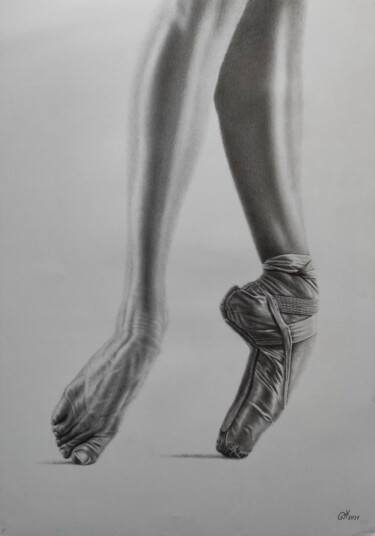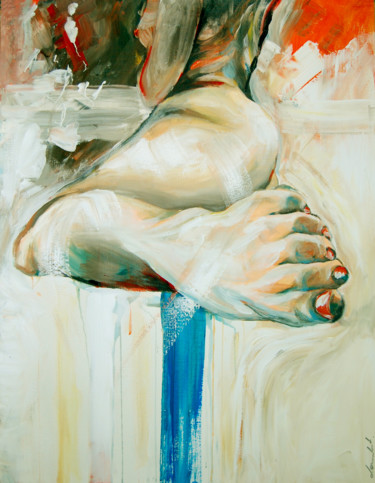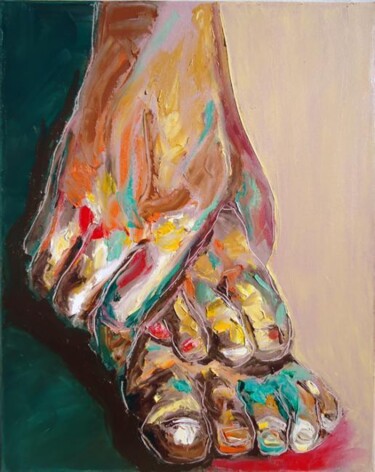Exploring the body in its fragments The brush soaked in flesh color, or the "colder" camera, are employed to explore the body in its fragments. Humanity is deconstructed, favoring the enhancement of details over the more classical overall view, exhaustively exemplified by the most famous nudes in the history of art. Now, abandoning the entirety of body language, it will be possible to understand how even a single foot, hand, or leg can communicate, making us understand the type of situation the depicted person feels and finds themselves in. Then we will begin to show works that simply depict feet, legs, and hands, and then arrive, only at the end of the story, at the most eloquent face. This latter, enriched by the expressiveness of the eyes, is capable of leading us further into the interiority of the depicted, a place farther from that external dimension, to which his limbs allude in a more superficial manner.
Feet
 FEET IN THE SUN (2021)Photograph by Jean Ponomarevsky
FEET IN THE SUN (2021)Photograph by Jean Ponomarevsky
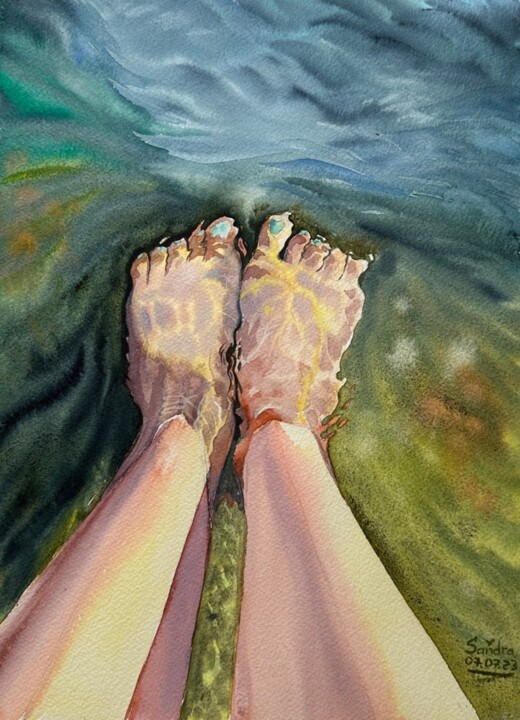 MEMORIES OF PEACETIME (2023)Photograph by Oleksandra Padushyna
MEMORIES OF PEACETIME (2023)Photograph by Oleksandra Padushyna
Jean Ponomarevsky & Oleksandra Padushyna
The tale of the human body's fragments begins with the feet of Jean Ponomarevsky and Oleksandra Padushyna, the former a photographer, the latter a painter. Why did I want to arrange their works visually next to each other, without any text interruption? I wished to make their similarities even more apparent, also giving you the opportunity to lay your eyes, quickly moving from one to the other. Then it will be evident how the two works present a similar framing, aimed at making us imagine that it was the same person who immortalized their lower limbs. Nevertheless, there are also significant differences between the two works: if the photographer's viewpoint is high, as if the shot was taken with the model's legs raised on a bed, the painter's point of view aims straight down to the ground, and more precisely, to the sea water. In addition, the use of light also differs, so much so that the light in the photograph seems to be filtered through a window, concentrating it exclusively in the central area of the shot, that is on the feet and the background. In Oleksandra Padushyna’s interpretation, however, the marine environment always appears kissed by the sun. This all generates coherent dialogues, where an interior is more suited to an intimate atmosphere, while the exterior appears to be less sheltered. Finally, about the two Artmajeur artists: Ivan Ponomarevsky, a photographer born in 1974 living in Georgia, first picked up a camera at eight years old, while the watercolorist Oleksandra Padushyna lives in Germany and loves to paint outdoors, capturing especially the waters of rivers, seas, and lakes. Let's move on to the legs!
Legs
 BALLET LEGS (2020)Photography by Mariia Kulchytska
BALLET LEGS (2020)Photography by Mariia Kulchytska
 RED LEG (2024)Photograph by Saint.E
RED LEG (2024)Photograph by Saint.E
Mariia Kulchytska & Saint.E
I open a brief parenthesis to clarify how, within this narrative, the arrangement of the images is also important and, for the legs, as in the case of the feet, I thought to juxtapose two works without breaking them up with a description. My choice is due to the fact that I imagined the rapid succession of the works of Mariia Kulchytska and Saint.E, thinking about how this creates an illusion of movement. In fact, it will be like thinking of seeing the same model, who, at the beginning keeps her legs close together, and then decides to move them, spreading them apart, thus generating a new visual context. Let's start now with the description of the first shot, intended to freeze in time the suspended legs of a ballerina, who keeps her limbs close to each other, to position them at the center of the photographic medium, where the focal point of interest of the shot concentrates, exuding all the discipline inherent in classical dance. On the other side is Saint.E with his greater transgression and desire to dare, which takes shape in the features of a red shot that, in addition to the legs spread at the two ends of the work, also shows the seductive rear of a model in high heels. The comparison between the two artists thus reveals two different approaches to art, aimed at speaking distinct personalities, one more conservative, balanced, and classical, the other more irreverent and provocative. Now we come in fact to tell something more about the two photographers: Maria Kulchitskaya is a professional ballet photographer with a background in art history, Saint.E, on the other hand, is a photographer passionate about portraits and artistic nudes, who has developed a particular interest in exploring bodily expression and human beauty. We have reached the turn of the hands and, since the selected works do not present particular affinities, they will be investigated one at a time, something that will be repeated when I get to the faces.
Hands
 HAND (2021)Photography by Ivan Cordoba
HAND (2021)Photography by Ivan Cordoba
HAND (2021)Photography by Ivan Cordoba
Let's start with the hand of Ivan Cordoba and try to interpret it together, equipping ourselves with a healthy touch of imagination. At first glance, it reminds me of the gesture of someone who, before plunging into the abyss, seeks one last contact with the terrestrial world. Likewise, however, it could be the end of a heartfelt theatrical gesture, or the choreography of a dancer in motion. Surely the "fragment" of the depicted subject wants to attract our attention, but why? What does this hand want to tell us? I can understand the meaning of the said gesture with greater certainty, referring to the words the artist has dedicated to it: "This photograph embodies the essence of beauty and grace with remarkable delicacy. At its heart, this image tells a story of exquisite simplicity, where a hand, delicate and divine, emerges as the focal point of the narrative." Everything is made even clearer and more evident by the contrast between the clarity of the background and the shadows cast by the main subject, intended to sculpt and dissect it in its forms and its message. In fact, "every curve and contour of the limb echoes a myriad of stories, whispered through the centuries. The fingers, long and slender, extend into the frame resembling the ethereal branches of a delicate tree, their elegance challenging the most beautiful creations of nature." It now seems to understand that this vision was born to contemplate the nature of man, his form, his beauty, his long history, through the aesthetic synecdoche of the sinuous shapes of a woman's hand. This intent is thoroughly achieved, as we pause to look at the subject with admiration, caught in understanding what is not given to see and, at the same time, lost in what we see: a fragment of all humanity.
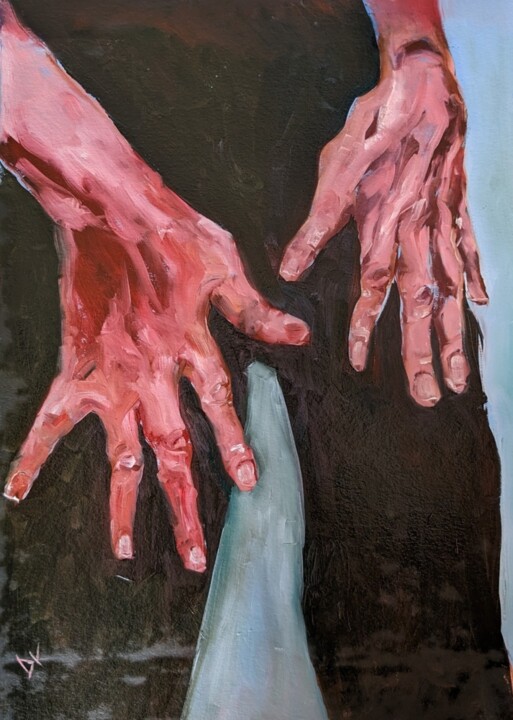 HANDS (2023) Painting by Diana Knepper
HANDS (2023) Painting by Diana Knepper
HANDS (2023) Painting by Diana Knepper
Continuing to discuss hands, I now promote a comparison, as in Diana Knepper's expressionism the search is no longer for aesthetic satisfaction, but for an explicit and revealing allusion to a specific motion of the soul. In this regard, the resulting signs of trembling come to mind. I imagine that the depicted person has endured one of life's many trials and that following this, they experienced intense stress. I venture to think of them watching their large pink hands sweat and move compulsively, while they attempt to stop them with their mind. At the same time, they might also simply be contemplating them, obsessively thinking back on what they have just experienced. Speaking now of the artist, Diana indeed recognizes painting as a means of self-discovery, aimed at distancing her from a superficial view of existence. During this journey, she was assisted by the example of great masters, immersing herself in the world of Van Gogh, Monet, Sorolla, Picasso, and Modigliani, models that place her work midway between the emotionality of Post-Impressionism or Expressionism and the brushstrokes of Impressionism.
Encounters
 EVOLUTION #2 (2013) Photography by Pietro Cenini
EVOLUTION #2 (2013) Photography by Pietro Cenini
EVOLUTION #2 (2013) Photography by Pietro Cenini
On Artmajeur, I looked for works where everything I have described so far could meet. In response, I found two works, a photograph and a drawing, in which, effectively, feet, hands, and legs are immortalized in unison. Starting with Cenini's shot, what we see, a "congregation" of legs, hands, and feet, is due to the pose assumed by the model, which, as the photographer himself reveals, was inspired by the quadrupedal position assumed by humans during their evolution. All of this, narrated in black and white, leads us even more back in time, immersing us in primordial instincts, as well as animalistic gestures and cries. Regarding Cenini, the Italian photographer trained in the USA, he sees art as a means to capture interiority, as well as emotions and moods often hidden from view. His aim is to make all this visible, alluding also to alternative perceptions of what generally appears evident. As a result, when we look at his works, we can imagine completing them with sounds and smells, aimed at making everything even more authentic, almost real. From a technical standpoint, besides the fact that the post-production process is substantial for the artist, he often combines multiple shots, a feature that is nevertheless rarely evident in the final results.
 HANDS-4 Drawing by Katerina Evgenieva
HANDS-4 Drawing by Katerina Evgenieva
HANDS-4 Drawing by Katerina Evgenieva
Now the focus shifts from quadrupedalism to evolution, as what Evgenieva's drawing seems to depict is simply a model of our times, who appears bent over in order to hug her ankles. These, probably shy and embarrassed by the contact, seem to bend slightly towards the left, followed by the caress of sinuous and slender hands, which gently trap them. The serpentine line, quite erotic, generated by the aforementioned meeting, represents the main motif of the work, aimed at being placed at the center of the medium. This sensual scene is not only observed by the viewer, but also by the arms, legs, and knees, which are excluded from the contact, along with the tips of the toes. Finally, it is clear how Katerina Evgenieva, a Bulgarian painter born in 1977, has transformed a likely routine scene, such as touching parts of the body, into an erotic and curvilinear composition, perhaps aimed at instilling the cult of self-love.
Face
 GOLDEN MEAN #9 (2022) Painting by Jonathan Mcafee
GOLDEN MEAN #9 (2022) Painting by Jonathan Mcafee
GOLDEN MEAN #9 (2022) Painting by Jonathan Mcafee
We have reached the face, in this case, of a blonde girl, who wears her hair behind her ears and parts it in the middle, portrayed while looking straight into our eyes without any hesitation. She is self-assured, but perhaps she hasn't noticed that she has a bit of paint on her face. Jokes aside, it is precisely these splashes of color, often arranged on the faces of the depicted, that make Jonathan Mcafee's works unique. But let's hear what the artist has to say about it: Golden Mean #9 "is part of my ongoing exploration of color, as I experiment with layering my brushwork and combine different elements and painting styles. With this approach, I take my expressive portrait paintings and then draw over them with simple scratches and lines." Moreover, the American Jonathan McAfee stands out for his unstoppable will to explore human form and expressive potential, in order to reveal the psychological aspects of the subjects, who are not only reproduced in their physical characteristics but also in the concepts of identity, memory, and emotion. To do all this, he constantly seeks the interaction between color and canvas, as well as the rendering of movement and energy, through the use of sometimes thick and gestural brushstrokes.
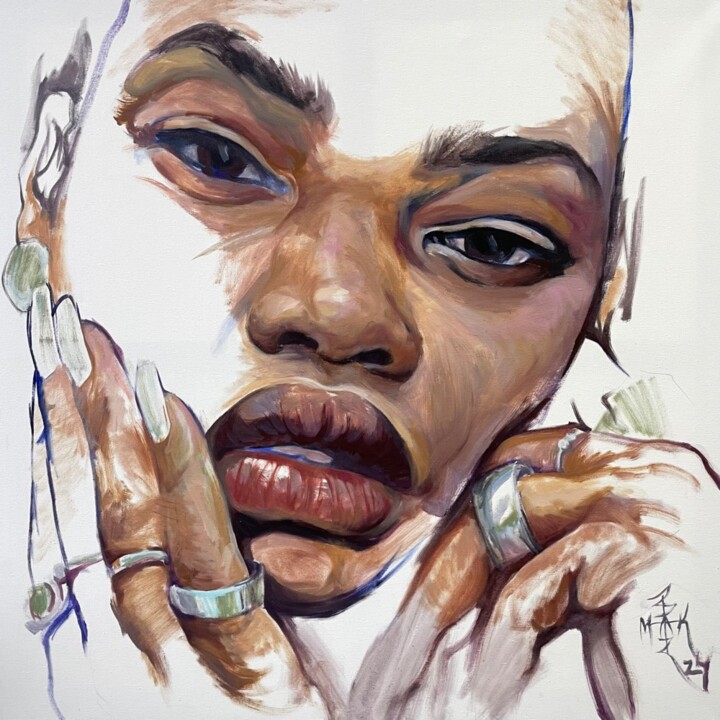 SILVER RINGS OIL PAINTING (2024) Painting by Varvara Maximova
SILVER RINGS OIL PAINTING (2024) Painting by Varvara Maximova
SILVER RINGS OIL PAINTING (2024) Painting by Varvara Maximova
When we look at the painting by Varvara Maximova, the first thing that captures our attention are those soft and sensual slightly parted lips. Immediately afterwards, we move on to contemplate the intense gaze. Finally, we also notice some fingers wearing silver rings. What do these two body parts have in common? The color! In fact, in "unfinished" works, the eye generally first lands on the "finished" parts. But what is meant by "paintings not finished but intended to be"? This concept refers to works of art where the artist has chosen to leave the piece intentionally incomplete, but with the intention that it is still interpreted as complete or finished by the viewer. This can be done for a variety of artistic reasons, such as creating a sense of mystery, inviting the observer's involvement in interpreting the work, or to express a sense of movement or transition. This approach can add conceptual and emotional depth to the artwork, leaving room for the viewer's imagination to complete the picture according to their interpretation. Now, speaking of Varvara Maximova, the contemporary artist dedicates herself exclusively to the genre of portraiture, through which she celebrates different types of women, promoting multiple models of femininity.


 Olimpia Gaia Martinelli
Olimpia Gaia Martinelli
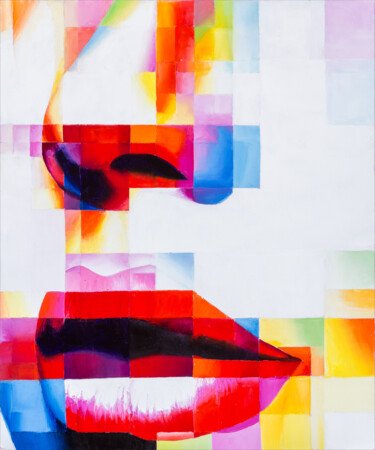


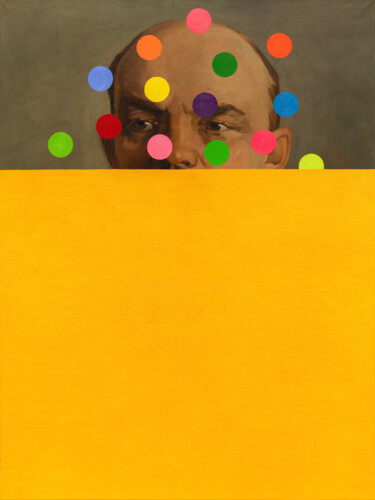



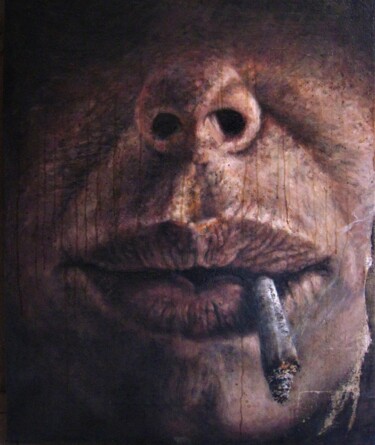







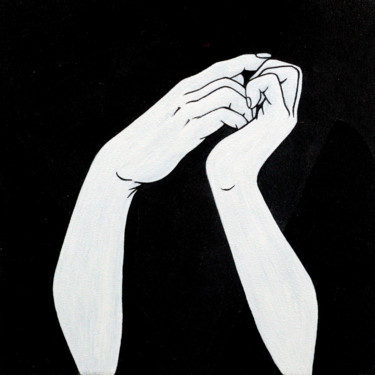





-1a.jpg?v=1739640738)













